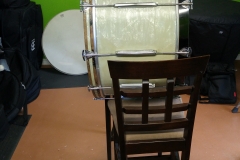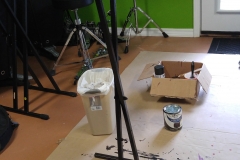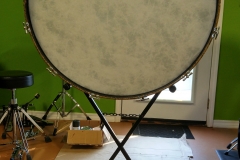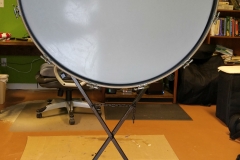When I first started at the Pensacola Bay Concert Band, they were using this old bass drum.
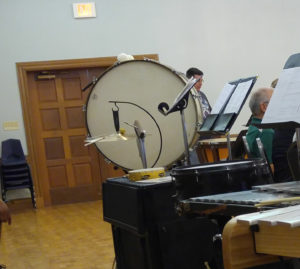
I came to learn that this was a hand-me-down drum from one of the local middle schools. It had just been sitting on a top shelf somewhere collecting dust for some time before it was given to the band. It did not sound all that great. There was a metal rattling sound when you played it, and some of the claws weren’t properly holding the hoop in place. Around October 2016, the band purchased a used 22×36″ Majestic bass drum. We were running out of space in our storage area at the church, so I offered to temporarily store the drum for them until they figured something out, so I did.
After quite a while, I mentioned I still had old this bass drum in storage, so they said they would just give it back to the middle school they got it from, so I brought it back to the church, but then noticed the drum using up storage space once again. They told me the middle school didn’t want it back, and so they asked me to get rid of it. Well, I had The Addams Family musical coming up, and it called for a concert bass drum. I figured I would just use this one.
So I used the drum in the show. I was able to minimize the rattle, but not completely. It did the job, but it didn’t really sound that great. Not long ago, I decided to give it some love. Maybe I’ll use it again somewhere else someday.
So, with a little bit of research, I came to learn that this is a 16×32″ Ludwig “White Marine Pearl” concert bass drum, which were made in the 1960’s and early 1970’s. The lack a serial number suggests this drum was made sometime before 1964. It has a mahogany shell, and the interior of the shell is natural, not white (1961-1967), so this drum was most likely created in 1960. One of the hoops is original, but the other is a black replacement. One side had an unlabeled cheap white head, and the other side was a Remo Weather King bass drum head that had seen better days. The head was labeled “Playground Music Center”, apparently a reference to a music store out in Ft. Walton Beach.
I thought to put an Evans Strata head in place of the old Remo head and use that as a “batter head” and leave the white head as is for a side head. It is a crappy head but it is in good condition. I found a brand new, in-box Remo Fiberskyn F1 Head on eBay, so I bid the minimum and won (ha!).
I was able to bend some of the tension rods and claws to be more straight… I thought to replace some of these, but doing so wouldn’t be simple to find replacement parts. I decided to just to the best I could. I put some WD-40 in each side of the lugs, and I gave the drum shell several good wipe downs, inside and outside of the drum. I filled up my trash can with the decades of dirt and gunk this thing had collected.

I also used some metal polish and gave all the tension rods, lugs, and claws a nice, reasonable shine, because I’m obsessive. I then checked if the white side head was balanced, and of course it was not, so I cleared the head with my DrumDial, setting it all to about 78. I then added the new Fiberskyn head to what I’m calling the batter side and set it to about 82 give or take. The sound is much improved. I was able to remove the rattle sound for the most part, although if I strike it very hard, I can still hear it (along with everything else in the room that’s shaking).
I also need to remove rust and repaint the stand that it came with. I will use the same Rust-Oleum paint I used on the Chimes stand and the Brake Drums as before. Might as well keep the color consistent.
I highly recommend you use headphones with the video below to head what it sounds like. Apologies up front, it isn’t so easy to hold a phone and play a drum at the same time.
Sounds pretty good for a free 32 inch bass drum!
Update for January 17, 2018. I wanted to show what the old head looked like, which has already gone through trash pick up.
I particularly liked how there are six pink arrows letting me know specifically where to aim… you know… in case I forget.
Anyway, the drum sounds much better now, and the only thing left to do was make the stand look a little nicer.
So, I shaved off some rust and painted it with the same paint I used on the chimes stand.
The stand appears to be a Ludwig LFP302BKS, but much of the powder coat had worn off and rusted underneath. I’m not sure how old it is, as today’s models use a metal bar rather than a chain to adjust the stand height.


